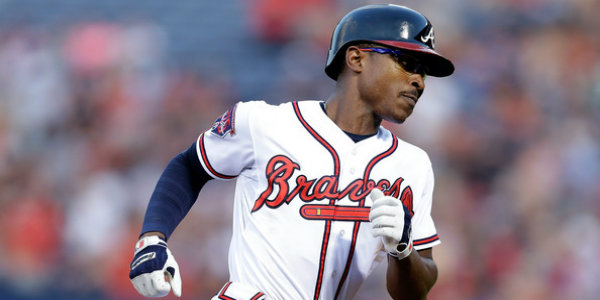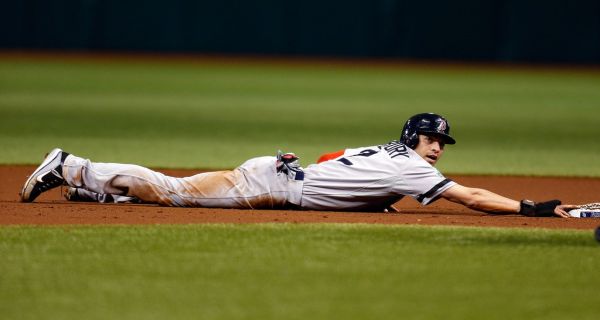2014 Fantasy Baseball: The B.J. Upton Lesson


Sometimes a player’s struggles seem to come out of nowhere. Statisticians can predict a lot of things with mathematical models, but they can’t predict everything. Steve Blass was instrumental in helping the Pirates win the 1971 World Series. The very next season he couldn’t find the strike zone anymore. The same thing happened to Mark Wholers and Rick Ankiel more recently. On the position player end, Chuck Knoblauch went from an all-star second baseman to someone that hit Keith Olbermann’s mother in the stands.
So, when B.J. Upton signed his five year, 65 million dollar deal with the Braves, it seemed like a good enough investment in the future. Coming into the 2013 season, he averaged 19 home runs and 36 stolen bases a season. Furthermore, he was at least an average fielder in center field. So, while he normally carried a lower batting average, he seemed like a guy that would give them enough elsewhere to make the contract worth its money.
Obviously, that hasn’t been the case to date as he has hit near the Mendoza line the last season and a third and has seen his power and speed numbers go in the toilet. The question from here (and for other executives) is whether his fall from grace was foreseeable or not. In order to do that, we will look at all of his completed seasons (including last year) to see if there was noticeable decline or whether it truly came out of nowhere.
|
PA |
AVG |
HR |
R |
RBI |
SB |
BB |
|
| 2007 |
548 |
.300 |
24 |
86 |
65 |
22 |
65 |
| 2008 |
640 |
.273 |
9 |
85 |
97 |
44 |
97 |
| 2009 |
626 |
.241 |
11 |
79 |
57 |
42 |
57 |
| 2010 |
610 |
.237 |
18 |
89 |
67 |
42 |
67 |
| 2011 |
640 |
.243 |
23 |
82 |
71 |
36 |
71 |
| 2012 |
633 |
.246 |
28 |
79 |
45 |
31 |
45 |
| 2013 |
446 |
.184 |
9 |
30 |
44 |
12 |
44 |
At first blush, we see two distinct trends going on with B.J. Upton. The first trend is that fans habitually expected more out of him because of the averages he was able to produce the first two seasons. Eventually, the data tells you who you are. Upton was a .240ish hitter who could draw his fair share of walks. So, his OBP was normally respectable. Add to that some impressive power and speed and you could see why the Braves thought they were getting a productive center fielder.
Unfortunately, the second trend cannot be found in these numbers. Some organizations rely more heavily on analytics than others. Some fantasy players are the same way. A casual player will look at what seemingly looked like annual 20 home run and 30 steal production and plug him in accordingly. When we peer underneath the rock we see some very alarming numbers that pointed towards decline.
|
BABIP |
SO% |
BB% |
Oswing |
Contact |
|
| 2007 |
.393 |
28.1 |
11.9 |
19.1 |
72.8 |
| 2008 |
.344 |
20.9 |
15.2 |
15.0 |
80.5 |
| 2009 |
.310 |
24.3 |
9.1 |
19.6 |
76.9 |
| 2010 |
.304 |
26.9 |
11.0 |
25.3 |
73.5 |
| 2011 |
.298 |
25.2 |
11.1 |
27.2 |
76.7 |
| 2012 |
.294 |
26.7 |
7.1 |
32.7 |
70.6 |
| 2013 |
.266 |
33.9 |
9.9 |
25.7 |
66.9 |
Mathematical models rarely ever follow a straight line. If they did then everyone would be a data analyst. That being said, Upton’s data nearly follows that kind of line. In particular, his batting averages on balls in play (BABIP) follow a straight line down. Sure, his 2013 average was abnormally low, but his career trend was going down. If the trend continued you could have expected him to pull a .290 average in 2013 and maybe a .285 average in 2014. Oddly enough, that .285 average is not that far off what he is doing so far.
What we see is that Upton is a swing and miss kind of player. That was okay in his early seasons when he was swinging at a miniscule percentage of balls outside the zone (Oswing), but as that percentage stabilized closer to the league average those swing and miss tendencies began to hurt him. His drop wasn’t a straight line, but if you graphed the data you could see a definite trend. So, his lower numbers there shouldn’t have been a total shock.
Of course, the following can help explain the drop in batting average, but the absence of power and speed was also noticeable. Even if you distill out the effects of the lower batting average, you still see a drop in power and speed production. That can only be evaluated through the batted ball statistics. We will likely notice some trends there as well.
|
ISO |
SecA |
ROV |
LD% |
GB% |
FB% |
HR/FB |
|
| 2007 |
.209 |
.376 |
.338 |
19.6 |
42.9 |
37.6 |
19.8 |
| 2008 |
.128 |
.363 |
.318 |
18.9 |
50.5 |
30.6 |
7.4 |
| 2009 |
.132 |
.284 |
.263 |
15.4 |
44.3 |
40.3 |
6.8 |
| 2010 |
.187 |
.373 |
.305 |
16.6 |
39.7 |
43.7 |
11.0 |
| 2011 |
.186 |
.355 |
.299 |
18.3 |
40.9 |
40.9 |
14.1 |
| 2012 |
.208 |
.330 |
.288 |
18.6 |
40.3 |
41.1 |
16.7 |
| 2013 |
.105 |
.235 |
.210 |
18.9 |
45.1 |
36.1 |
10.2 |
If you’ve read my articles before, you might be aware of secondary average (SecA). It is a Bill James statistic that measures everything an offensive player brings to the table outside of batting average. In essence, it shows the hidden value of a player (since most fans focus on batting average). Upton’s secondary averages are consistent with a player that is chronically underappreciated. I’m sure the Braves were counting on that production.
I certainly can’t take credit for real offensive value (ROV), but I have not found that statistic on any of the official websites. It is essentially the combination of batting average and secondary average. As you can see, that number is taking the same kind of consistent dip as all of the other numbers we have looked at. Naturally, no one could have expected that kind of precipitous fall, but the Braves and fantasy fans should have expected some kind of drop off.
Part of that fall can be explained to a seemingly inexplicable drop in power. Except, his home runs per fly ball rate was right around the league average. Moreover, his career average coming into 2013 was just over 12 percent. So, that kind of a drop is not completely unpredictable. At the end of the day, Upton’s face plant of a season didn’t completely come out of nowhere like so many people would lead you to believe. The proof is in the fact that he hasn’t completely bounced back this season.
It is certainly a romantic notion to believe that positive and negative performance exists in a vacuum that we can’t predict. After all, if we can’t predict it then we are all absolved when the unforeseen happens. The inconvenient truth is that most performance can be predicted if you pay attention to the numbers behind the numbers. Let B.J. Upton serve as a lesson to us all.






1 Comment
Steve Blass was the poster child for inexplicable decline. He was a terrific clutch pitcher who suddenly couldn’t find the strike zone. He wasn’t the first, and obviously not the last.
Success in baseball is about the “long haul.” Most players don’t have that staying power. That’s why long-term contracts are such a gamble. http://bit.ly/StvezZ